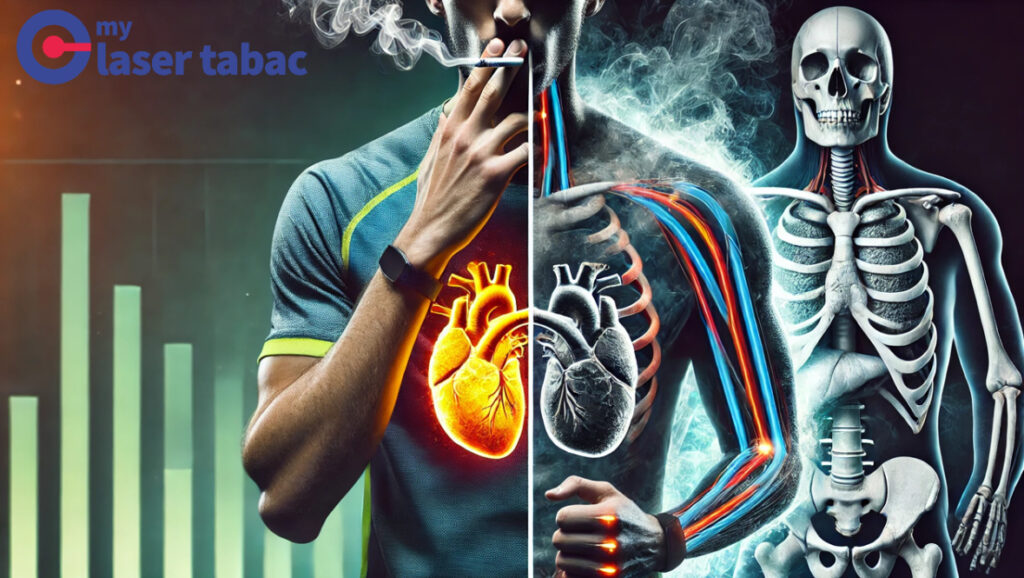Smoking is a harmful habit that impacts not only overall health, but also physical performance and endurance. Smokers, whether or not they are athletes, often experience a reduction in their ability to sustain prolonged effort. This article explores the scientific and physiological reasons behind this phenomenon, while highlighting the negative effect of smoking on the body and cardiovascular health.

Smoking and endurance: what’s the link?
Smoking directly affects the essential mechanisms that enable the body to sustain physical work. Endurance depends on oxygen supply, cardiac function and the ability of muscles to recover. These functions are significantly impaired in smokers.
The main factors behind reduced stamina
Reduced oxygenation:
- The nicotine and chemical residues in cigarette smoke disrupt oxygen transport in the blood.
- Carbon monoxide binds to hemoglobin, replacing oxygen. This reduces the supply to muscles and vital organs.
- Tobacco, cigarettes and smoking, especially passive smoking, are associated with an increased risk of cancer and cardiovascular disease.
Increased heart rate:
- Smoking accelerates the cardiovascular rhythm, even at rest. During exercise, smokers’ cardiac systems have to work even harder, reducing their ability to sustain prolonged exercise.
Inflammation of the respiratory tract:
- Smokers often suffer from chronic inflammation of the lungs, which reduces their respiratory capacity.
- The result: rapid breathlessness and premature fatigue during sporting activities.
- Smoking, passive smoking and exposure to cigarette smoke are associated with weight gain and an increased risk of cardiovascular disease, particularly heart attacks.

The effects of smoking on the cardiovascular system
Impact on the heart
The heart is a key organ in sporting endurance, and smoking puts constant pressure on it.
- Increased risk of cardiovascular disease: Smoking is a major cause of heart attacks and heart disease.
- Reduced cardiac performance: Cigarettes reduce the heart’s ability to pump blood efficiently, limiting the body’s capacity to meet the increased oxygen requirements of physical activity.
Impact on blood vessels
- Tobacco damages blood vessel walls, reducing their elasticity.
- This causes poor blood circulation, directly affecting muscles during sports.
Nicotine and its effects on physical endurance
What is nicotine?
Nicotine is a highly addictive substance found in cigarettes. It acts as a stimulant on the nervous system, but its effects on the body are not beneficial for athletes.
Immediate effects of nicotine on physical work
- Vasoconstriction: Nicotine reduces the diameter of blood vessels, which in turn reduces blood flow to muscles.
- Increased blood pressure: This forces the heart to work harder to compensate.
Long-term effects
- Prolonged nicotine consumption leads to reduced physical performance.
- Regular smokers see their endurance levels drop significantly compared to non-smokers.
Passive smoking: a danger to endurance
Even those who don’t smoke directly can be affected by other people’s smoke.
- Reduced oxygenation: Toxic substances inhaled during passive smoking affect lung capacity, even in non-smokers.
- Similar cardiovascular impacts: Exposure to smoke increases heart rate and reduces engagement capacity.
Passive smoking is therefore an obstacle to sporting activities, even for those who don’t smoke themselves.
Carbon monoxide: an enemy of effort
Carbon monoxide, present in cigarette smoke, is particularly harmful to physical performance.
Why is it dangerous?
- It binds to hemoglobin, preventing oxygen transport.
- It reduces the efficiency of muscles and organs during exercise.
Impact on athletes
- Smoking athletes experience faster fatigue and longer recovery times after exercise.
- The presence of carbon monoxide in the blood reduces the ability to perform at high levels.
The benefits of quitting smoking for endurance
The good news is that the effects of smoking on endurance are not irreversible.
Progressive recovery
- After 48 hours: Carbon monoxide disappears from the blood, improving oxygenation.
- After a few weeks: Lung capacity begins to regenerate.
- Long-term: Cardiovascular risks are reduced, and endurance improves significantly.
Benefits for athletes
- Better respiratory capacity.
- A more stable heart rate during exercise.
- Faster recovery after physical activity.
The anti-smoking laser: an effective solution for regaining stamina
For smokers who want to regain their stamina and improve their health, quitting smoking is the first step. At MyLaserTabac, we offer an innovative, natural method to free you from addiction.
How does the anti-smoking laser work?
The laser stimulates specific points in the ear, helping to reduce nicotine cravings and withdrawal symptoms.
Why choose MyLaserTabac?
- Effective from the very first session: Most of our customers stop smoking immediately.
- Natural method: No nicotine substitutes or medication.
- Personalized support: We guide you every step of the way.
Book an appointment today at one of our centers in France via the Rendez-vous tab on our website. Take control of your health and regain your stamina.
Conclusion
Smoking, tobacco, cigarettes and passive smoking are all risk factors affecting smokers’ cardiovascular health, endurance and sporting performance. Smoking less or quitting altogether can improve endurance, lung capacity and recovery.
For those wishing to maintain good physical condition, it is essential to take into account the harmful effects of smoking on health and to consider stopping smoking. Smoking cessation, with the help of nicotine substitutes, laser therapy and sport, can be an effective way of reducing the risks associated with smoking.
MyLaserTabac offers a natural smoking cessation method with an anti-smoking laser. If you’re a smoker who wants to improve your sporting performance, preserve your cardiovascular health and reduce the risks associated with smoking, book an appointment with MyLaserTabac today and discover a healthier, more energetic life without tobacco. Don’t let smoking limit your sporting potential and overall well-being.







